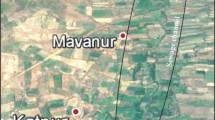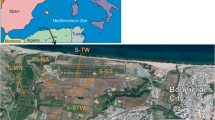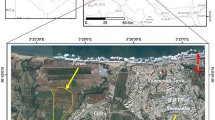Abstract
In Egypt, the reuse of sewage water on the sandy soil of El-Gabal El-Asfar Farm took place since 1923. The present work discusses the physical and chemical characteristic of this water. Different soil samples that were irrigated by sewage for different increasing periods were collected to investigate the changes in the soil texture as well as accumulation of heavy metals by the soils according to the period of irrigation (7, 12, 23, 40, 50 and 75 years). The overall results revealed that the longer period of irrigation demonstrated higher level of metal accumulation in the soil. The progressive increase of metals in the soil represents serious risk to the cultivated plant (as a food cycle). It is; therefore; recommended to decrease the level of heavy metals in sewage water via further simple wastewater treatment. For this purpose, a laboratory attempts were carried out to decrease the level of metals in the sewage water. Lime, as coagulant, and/or the dried leaves of Water Hyacinth plant were examined. Remarkable elimination of metals was demonstrated. It was also recommended to use the given sewage water for cultivating the woody or Lumber trees (for high economic revenue) to reduce any expected metal hazard in the food chain.
Access this chapter
Tax calculation will be finalised at checkout
Purchases are for personal use only
Preview
Unable to display preview. Download preview PDF.
Similar content being viewed by others
References
Abdel-Shafy, H.I., S. Anwer, S. Hassan and T. Yahia (2003) "Risk assessment of sewage reuse on the sandy soil of Abu-Rawash Desert, Egypt" J. Environmental Protection Engineering, 01 (2003).
Abdel-Shafy, H.I. and Aly, R.O. "Water issue in Egypt: resources, pollution and protection endeavors" Central European J. of Occupational & Environmental Medicine, 8(1): 1–21 (2002).
Abdel-Shafy, H.I. and U. Troeger - Report 1998, Bilateral Egypt-Germany Scientific & Technological Cooperation, National Research Center and International Research Center, Juelich GMBH, 86 pages (1998).
Abdel-Sabour, M.F., Abdel-Shafy, H.I., and T.M. Mosalem "Heavy Metals and Plant growth yield as effected by sewage sludge and water hyacinth compost applied to sandy soil" J. Environmental Protection Engineering, Vol. 27(2):43–53 (2001).
American Public Health Association (APHA), Standard Method For the Examination of Water & Wastewater, p. 385, APHA, AWWA, WPCF, Washington, D.C. (1995).
Culp, G.I. and Culp, R.I. "New Concepts on Water Purification" Von Nostrand Reinhold Environmental Engineering Series, NY, 247 pp (1974).
Egyptian Environmental Protection Agency, Law 4/1994: legislation-controling disposal of wastewater, 1994.
El-Gamal I.M. and H.I. Abdel-Shafy "Role of micropollutants in the evaluation of wastewater in Egypt" J. Environ.l Protection Engineering,16(3–4): 5–13 (1990).
El-Gamal, I.M., and H.I. Abdel-Shafy "Role of land irrigation by liquid sewage on the uptake of metals and nutrient elements by citrus plants, Biomass & Bioenergy, Vol. 1, No. 5, pp. 275–280 (1991).
Foerstner, U. and G.I. Wittmann, Metals Pollution in the Aquatic Environment (Springer-Verlag, Berlin-Heidelberg, N.Y.) page 485 (1983).
Freeman, H.M. Standard Handbook of Hazardous Waste Treatment and Disposal" U.S. Environmental Protection Agency, McGraw-Hill Book Co.: 9.19–9.28 (1988).
German J., G. Svensson, IWA 2ND WORLD WATER CONGRESS;Efficient water management-making it happen, Berlin 15–19 Oct., page 14, 2001
Hall, J.E., L'Hermite, P. and Newman, PJ. "Treatment and use of sewage sludge and liquid agricultural wastes. Review of cost Program-Commission of the European Communities, EUR 14330 EN (1992).
Jackson, M. L. (1967): Soil Chemical Analysis Prentice Hall, Inc Englewood Cliffs, N. J. laboratory of the Congress, M. A. S.
Lindsay, W. L., and Norvell, W. A. (1978): Development of a DTPA soil test for Zinc, Iron, Manganese and Copper. Soil Sci. Soc. Am. J., 42: 421–428.
Mansour, S. F. (1996): "Development of sandy soils under sewage water irrigation". M. Sc. Thesis Faculty of Agric., Cairo Univ.
Piper, C. S. (1966): "Soil and Plant Analysis". Interscience Publishers, Inc. New York. WHO: World Health Organization, Geniv, 1978.
Author information
Authors and Affiliations
Editor information
Editors and Affiliations
Rights and permissions
Copyright information
© 2006 Springer
About this paper
Cite this paper
ABDEL-SHAFY, H.I., ABDEL-SABOUR, M.F. (2006). WASTEWATER REUSE FOR IRRIGATION ON THE DESERT SANDY SOIL OF EGYPT: LONG-TERM EFFECT. In: Hlavinek, P., Kukharchyk, T., Marsalek, J., Mahrikova, I. (eds) Integrated Urban Water Resources Management. NATO Security through Science Series. Springer, Dordrecht. https://doi.org/10.1007/1-4020-4685-5_31
Download citation
DOI: https://doi.org/10.1007/1-4020-4685-5_31
Publisher Name: Springer, Dordrecht
Print ISBN: 978-1-4020-4683-4
Online ISBN: 978-1-4020-4685-8
eBook Packages: Earth and Environmental ScienceEarth and Environmental Science (R0)




